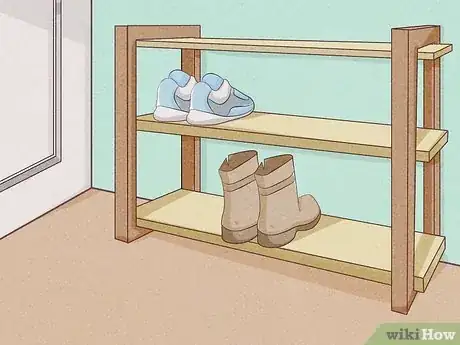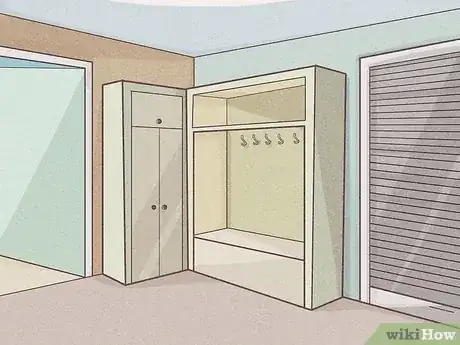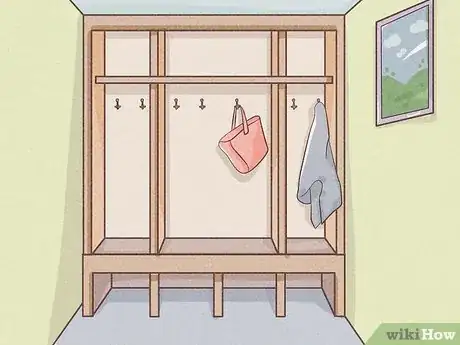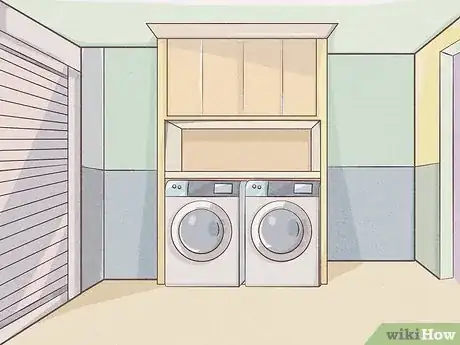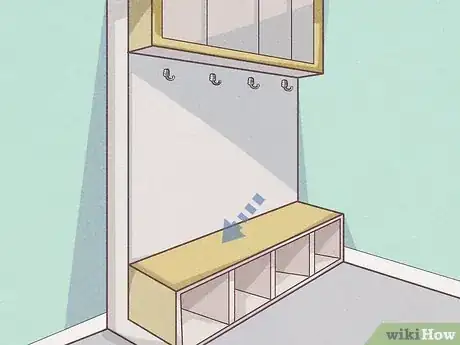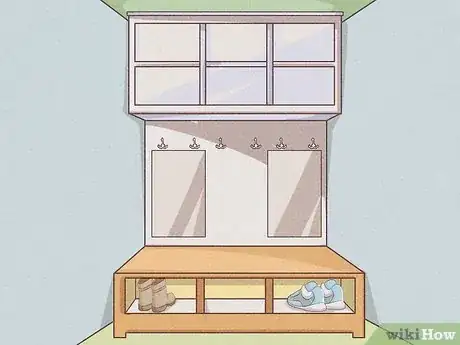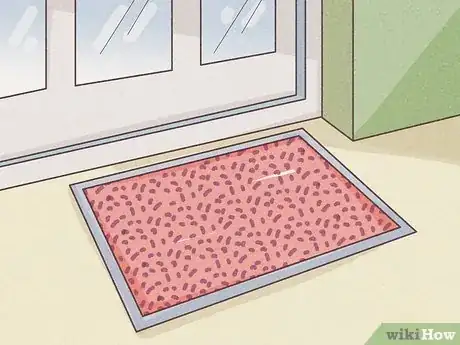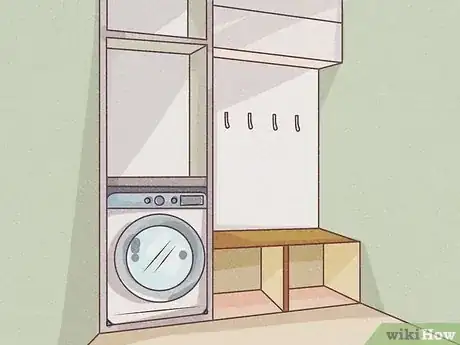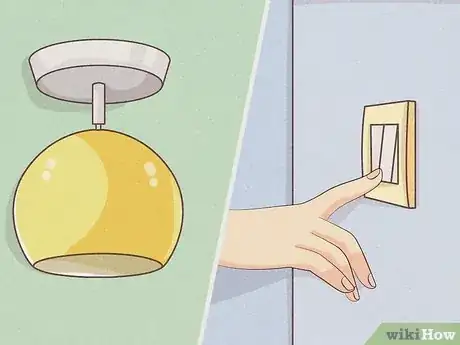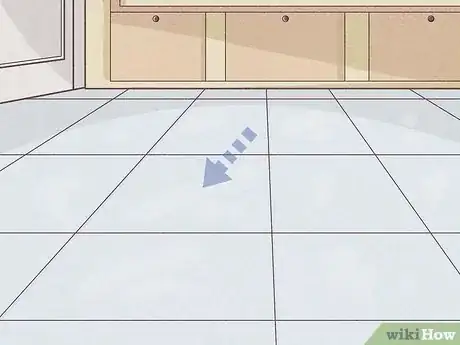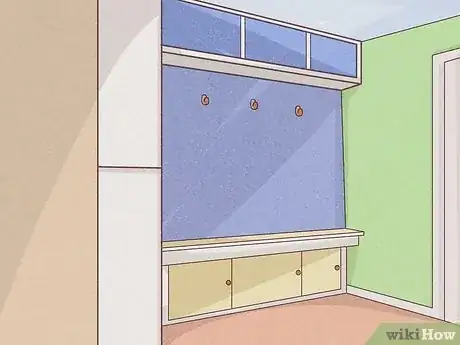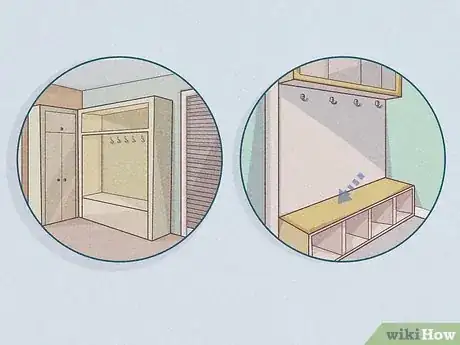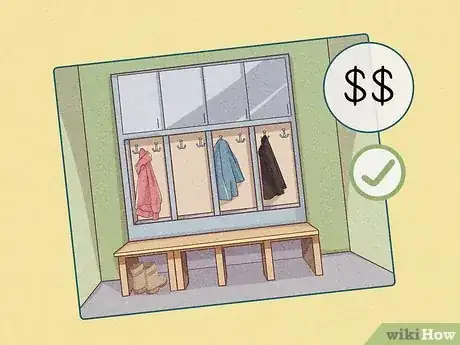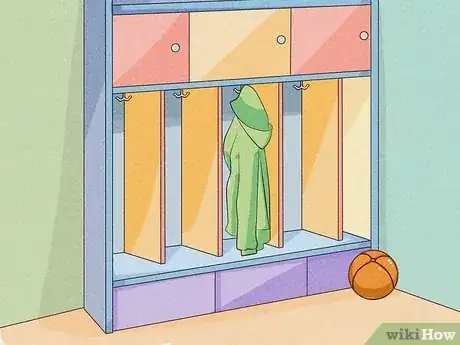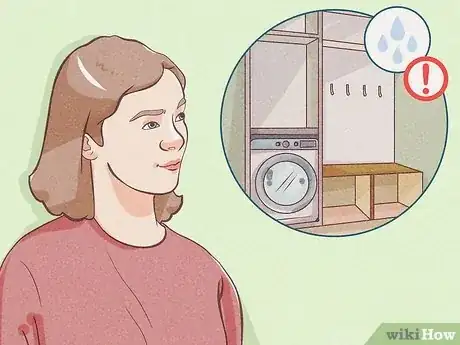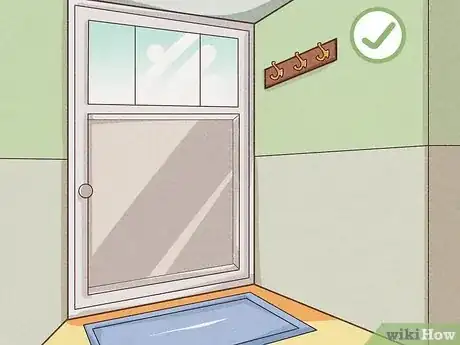This article was co-authored by Garrison Hullinger and by wikiHow staff writer, Eric McClure. Garrison Hullinger is an Interior Designer and the President of Garrison Hullinger Interior Design (GHID). With more than 15 years of experience, he specializes in client-centered design that balances beauty and warmth with comfort and functionality. Garrison and GHID’s work has been featured in numerous publications such as The New York Times, The Wall Street Journal, and Interior Design Magazine. Garrison attended Oklahoma Christian University.
There are 9 references cited in this article, which can be found at the bottom of the page.
Buying or remodeling a home and wondering what exactly a mudroom is and whether it’s necessary? These small, unique spaces at the entrances of homes are growing in popularity, and some homeowners and designers wouldn’t live without one. In this article, we’ll break down what a mudroom is, what a good mudroom should include, and the pros and cons of including a mudroom in your home.
Things You Should Know
- A mudroom is sort of like a decompression chamber for your home—it’s where you take your coat and shoes off before you reenter your cozy home. When you step into the house, there are probably things you don't want to carry into your home, and it's nice to have a place to simply kind of shed the day off.
- Use your mudroom to store your shoes, hang your jackets, and organize your seasonal gear such as hats and gloves in the winter.
- A mudroom may be a small area between your front door and your home, or a larger laundry area between a garage and main living area.
- You do not need a mudroom, but they’re especially helpful if you live in an area that gets a lot of snow, you love gardening, or you have a large family.
Steps
What is a mudroom?
-
1A mudroom refers to the entryway where you take your dirty shoes off. A mudroom is a common feature in homes where it rains or snows on occasion. When you enter your home through the front door, the mudroom is the small area you initially walk into where you can take your dirty shoes, wet coat, or winter gear off so that you don’t track mud, water, or dirt through your home.[1] X Research source
- Mudrooms can be super small (around 4 by 4 feet (1.2 by 1.2 m)) or basically the size of a normal bedroom. You almost always only find these rooms in single family homes, though.
- Depending on where you live, mudrooms may be called “utility rooms” or “entryways.”
- Mudrooms are comparable to a lobby or vestibule in a commercial building.
-
2A mudroom can also be the area between a garage and a home. If a garage is attached to a home, the mudroom will typically be located in between the garage and the main floor of the home, since this is where you’d typically enter the building when you drive home. These mudrooms usually double as a laundry room, and they tend to be bigger than the mudrooms you’d find at front doors.[2] X Research source
- Depending on where you live, these mudrooms may be more commonly referred to as “laundry rooms.” The fancy mudrooms may be known as “foyers.”
- In larger, older homes, the mudroom may be between the garden and main floor.[3] X Research source
What do you use a mudroom for?
-
1Taking your muddy shoes off If your shoes or boots are dirty, walking right into your living room is probably a bad idea. If you prioritize a clean home, you can use a mudroom to take your shoes or boots off without getting your precious hardwood or carpeted floors dirty.[4] X Research source
- This is especially helpful if you have children since you have a special area where they can get undressed without making a mess.
-
2Storing coats, winter gear, and seasonal items Depending on the size of the mudroom, you may be able to use it to hang winter coats, rain gear, or clothing you only wear occasionally based on the weather. If you have a lot of specialized shoes or gear, keep it in the mudroom so you can grab it when you need it.[5] X Research source
- Keep your umbrellas next to the door in the mudroom so that you can grab them quickly on your way out.
- Think about stuff that you’d put on right before you step out of your home. Rain boots, snowsuits, scarves, and the like are all going to belong in the mudroom.
-
3Organizing and doing laundry If you’ve got a bigger mudroom between your garage and the first floor of your home, that’s probably where your washer and dryer are. As such, it’s the perfect place to wash clothes, sort laundry, and fold everything before taking your clothes where they belong.[6] X Research source
- Pro tip: keep a second hamper in the mudroom. This way you can shed especially dirty clothes when you walk in the door without needing to drag them up to your bedroom.
What should you put in a mudroom?
-
1Put a shoe rack, hooks, and a wall organizer in a smaller mudroom. If you’ve got a smaller mudroom in the entryway, you may not be able to fit any larger furniture. Still, a practical solution might be to fit a small shoe rack to put your kicks on before stepping out. Wall hooks or a hanging coat rack are great for hanging coats up and keeping them out of the way. Finally, a hanging mail/key organizer will provide some helpful storage.[7] X Research source
- You don’t want to overcrowd a small mudroom at your main door since you don‘t want people to feel crowded or overwhelmed when they enter your home.
-
2Include a seating bench with storage for clothing in a bigger room. If you have room, a seating bench is essential for a mudroom. This way, you can sit down to take your shoes on or off. If you’d have space, buy one of those benches with a backing that has hooks at the top for coats, hoodies, or rain gear. If there’s shelving at the top, you can store shoes you don’t wear regularly, or other gear.[8] X Research source
- You can even get a seating bench that opens up and doubles as storage if you want the extra room!
-
3Consider storage cubbies for shoes, blankets, and seasonal items. Installing or placing storage cubbies in a mudroom can make storage and organization a lot simpler. This way you can group like-items together. If you have a family, you can even give each family member their own set of cubbies![9] X Research source
- If you have younger kids, giving them cubbies in a mudroom is a great way to help them acquire executive thinking and organizational skills.
-
4Get a durable, washable rug for all of the mud, water, or snow. You’re probably going to track in a lot of gnarly stuff if you live in an area where people use mudrooms, so get a rug where you can wipe your feet without feeling bad about getting it dirty. Any rug made of thick cotton, washable polyester, or acrylic blend should hold up just fine.[10] X Research source
- Those outdoor welcome mats made of coir, rubber, and jute grass are great if your mudroom isn’t especially big.
- Ruggable has blown up in popularity recently for offering a variety of washable rugs that look and feel great.
-
5Put your washer and dryer in a mudroom if they aren’t in the basement. If you’re designing a home or adding a mudroom and you don’t have a dedicated spot for your washer or dryer yet, a mudroom may be the perfect area for them if it’s off the garage. This way, you won’t have to lug dirty clothes all the way to the basement, and you can hang coats and hoodies immediately after you’ve washed them.[11] X Research source
- Putting a washer and dryer on the main floor also makes it easier to run ducts outside.
-
6Include a sink to make cleaning up a breeze. If you’re building or buying and you can manage to include a sink in a larger mudroom, do it. You’d be surprised how convenient it is to have a sink near the entryway of your home. Get dirty after doing some yard work? Boom, easy spot to clean up before entering your home. Covered in dirt after running around with your kids? Everyone can clean up inside.[12] X Research source
- If you’re putting a washer and dryer in your mudroom, you kind of have to include a sink by default so that you have somewhere to drain the washer.
Design Tips for Mudrooms
-
1Keep the lighting practical. On more than one occasion, you’re going to come into your mudroom with dirty hands and messy clothes. If you’ve got some kind of fancy dial to turn the lights on or you need to reach under a lamp shade to find the light switch for your standing lamp, it’s going to be a hassle. Stick with simple overhead lighting that will be easy to turn on and off.[13] X Research source
- This isn’t to say you can’t pick a super interesting light fixture if you’re building or remodeling a home. The mudroom is a great place to make a statement design-wise since it’s the first impression people will get of your home when they enter!
-
2Opt for durable but unique floor tiles. Hardwood flooring is likely to get scuffed up and carpeting will get trampled on with dirty shoes. Keep things easy to clean up by selecting tile that works with the remainder of your home. You could go with a textured, earthy look for a more rustic vibe, or select sleek, glossy tile for a more luxurious vibe.[14] X Research source
- Don’t be afraid to get colorful with the tile! This is a great place to showcase a tertiary color in your home’s color scheme.
- The classic black and white checkered pattern is a great option if you’ve got more of an art deco glam vibe going on.
-
3Make a statement with the colors or keep it neutral. If you’re building a cozy, farmhouse-style home, you’ll likely want to stick with neutral grays, whites, blacks, and beiges to set a warm tone for visitors. However, you can totally go wild if you want to flex your creative juices and you’re designing something a little more expressive and modern.[15] X Research source
- You and your guests won’t spend a ton of time in the mudroom hanging out. It’s more of a transitional area. As such, feel free to get a little fun and playful with the art and colors.
Where should you put a mudroom?
-
Put the mudroom wherever you plan on primarily entering the home. If you drive to work and there’s a garage attached to the home, put your mudroom between the garage and your living area. If you’ll mainly use the front door, put a small mudroom there. If you do a lot of gardening and you have a side door you’ll use, you can even place your mudroom at the side door.[16] X Research source
- You can totally include more than one mudroom if you’d like. Just keep in mind that mudrooms aren’t really livable space, so you don’t want to give up too much interior space if square footage is at a premium.
Are mudrooms worth it?
-
1They’re great value if you’re worried about a return on investment. If you’re building or buying a home and you’re wondering whether paying a slight premium for a mudroom is worth it, it almost certainly is. It will typically cost around $12,000 to add a mudroom to a home, but a beautiful mudroom can really add an air of luxury and comfort to a living space. When it comes time to resell the home, a well-designed and functional mudroom is likely to provide a solid return.[17] X Research source
- With that said, it’s unlikely that you should make a mudroom the breaking point between buying a particular home or passing.
- If you’re building a home and you can afford a mudroom, it’s likely worth the investment.
-
2Mudrooms are especially nice if you have a larger family or kids. If you’re home shopping for a family of 4 or more and you have young kids, the mudroom will serve an especially productive role. With so many sets of shoes going in and out of your home, the dedicated “get ready” space will keep the mess contained. You’ll also have some much-needed storage space for everyone’s outdoor gear.[18] X Research source
- If you’re just home shopping for you and a spouse, or you’ve got a lone teenage child, you can totally get by without a mudroom.
-
3They aren’t important if you live in an urban, temperate climate. If you don’t live in an area where it snows or rains a lot and you won’t be traveling a whole lot of dirt roads, a mudroom probably isn’t going to get much use. This doesn’t mean that the mudroom can’t help with storage, but it just won’t be as necessary for you.[19] X Research source
Do you need a mudroom?
-
No, your home can still be great without a mudroom. Let’s say your front door opens to the living room. You can replicate the functionality of a mudroom by simply laying down a thick entryway rug and putting up a coat rack. As far as laundry goes, you can always put a washer and dryer in the basement, or a closet. Don’t talk yourself out of a great home just because it’s lacking a mudroom![20] X Research source
- If you have a small closet next to your entryway, you can always use that for storage, winter gear, and shoes. You can remove the door or not, completely up to you.
You Might Also Like

 How to Get Spray Foam off Your Hands
How to Get Spray Foam off Your Hands






 How to Defrost a Samsung Ice Maker: A Quick Guide
How to Defrost a Samsung Ice Maker: A Quick Guide



References
- ↑ https://realestate.usnews.com/real-estate/articles/adding-a-mudroom-is-it-worth-it
- ↑ https://sunvalleymag.com/articles/the-evolution-of-the-mudroom/
- ↑ https://www.homesandgardens.com/advice/designing-a-mudroom
- ↑ https://sunvalleymag.com/articles/the-evolution-of-the-mudroom/
- ↑ https://sunvalleymag.com/articles/the-evolution-of-the-mudroom/
- ↑ https://sunvalleymag.com/articles/the-evolution-of-the-mudroom/
- ↑ https://www.goodhousekeeping.com/home/organizing/g25575495/mudroom-ideas/
- ↑ https://www.southernliving.com/home/organization/mudroom-ideas
- ↑ https://www.goodhousekeeping.com/home/organizing/g25575495/mudroom-ideas/
- ↑ https://www.nytimes.com/2021/02/02/realestate/how-to-design-entryway-organize-winter-gear.html
- ↑ https://www.chicagotribune.com/news/ct-xpm-2004-08-20-0408200144-story.html
- ↑ https://www.homesandgardens.com/advice/designing-a-mudroom
- ↑ https://www.homesandgardens.com/advice/designing-a-mudroom
- ↑ https://www.homesandgardens.com/ideas/mudroom-tile-ideas
- ↑ https://www.homesandgardens.com/advice/designing-a-mudroom
- ↑ https://www.homesandgardens.com/advice/designing-a-mudroom
- ↑ https://realestate.usnews.com/real-estate/articles/adding-a-mudroom-is-it-worth-it
- ↑ https://www.homesandgardens.com/advice/designing-a-mudroom
- ↑ https://www.nytimes.com/2021/02/02/realestate/how-to-design-entryway-organize-winter-gear.html
- ↑ https://www.bobvila.com/slideshow/these-14-ideas-are-the-next-best-thing-to-a-mudroom-52405
About This Article

